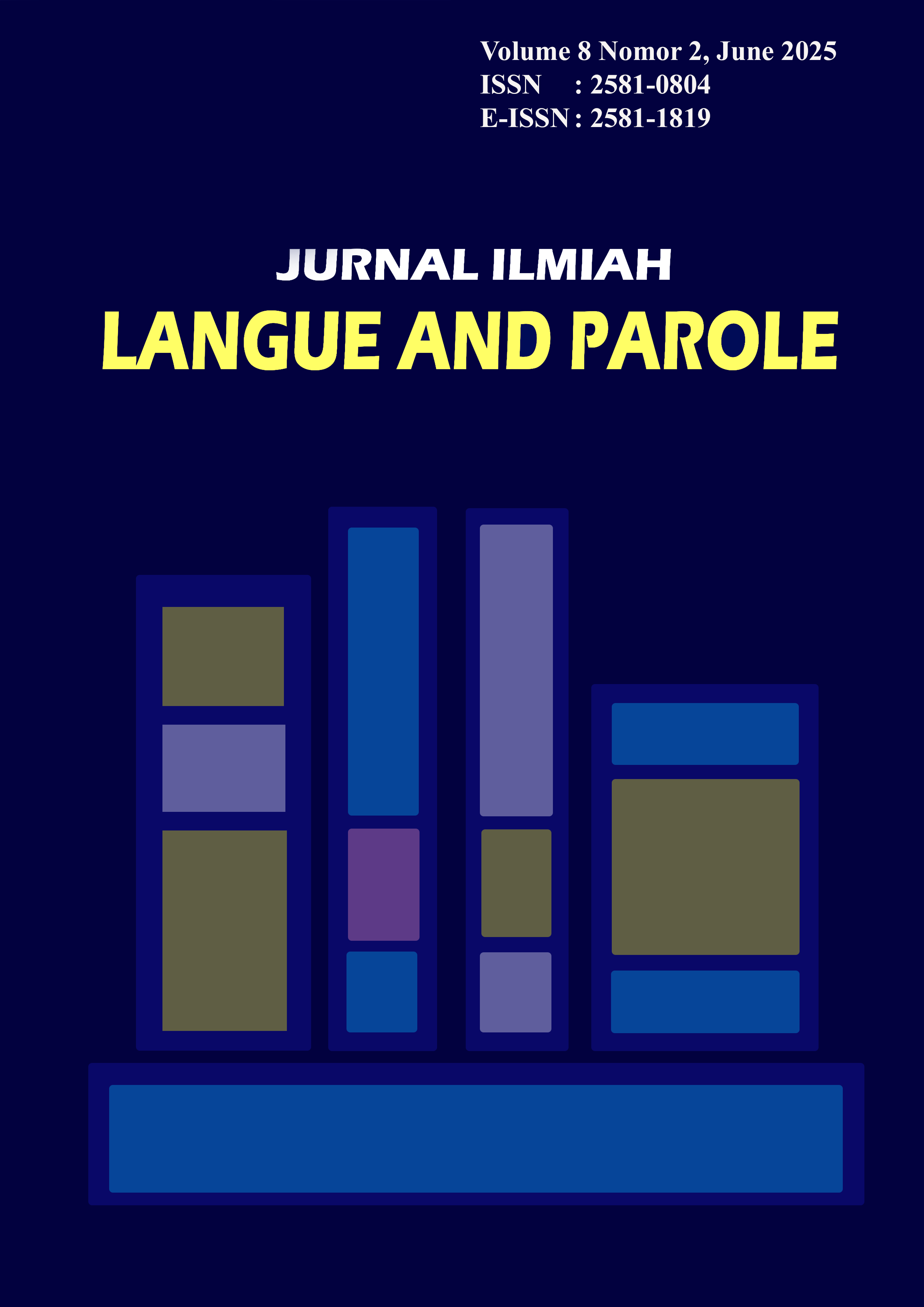Students' Views On Digital Technologies In Learning English For Specific Purposes (ESP) In University
DOI:
https://doi.org/10.36057/jilp.v8i2.744Keywords:
Digital technologies, English for Specific Purposes (ESP), Students’ perceptions, Technology integrationAbstract
This study explores university students’ perspectives on the use of digital technologies (DT) in learning English for Specific Purposes (ESP). While the integration of DT has been widely promoted, student perceptions remain underexplored, particularly in vocational higher education. The aim of this research is to examine students’ opinions on the role of DT in enhancing ESP learning and to identify the tools they frequently employ. A mixed methods design was applied with twelve participants from different study programs. Quantitative data were obtained through a Likert-scale survey on perceptions and digital tool usage, complemented by brief interviews for qualitative insights. Results indicate strong support for DT integration: 91.7% of students agreed or strongly agreed that DT enhances ESP learning, with no negative responses recorded. WhatsApp and YouTube were universally used (100%), followed by Zoom (91.7%), Google Classroom (66.7%), and Moodle (50%). Use of ESP-specific simulators was less common (33.3%). Students highlighted ease of access, interaction, and flexibility as key benefits, while limited exposure to specialized ESP tools was noted as a challenge. The study concludes that students hold positive views of DT in ESP, yet further investment in domain-specific applications is required to optimize learning outcomes.
Downloads
References
[1]Alexandre, B., Reynaud, E., Osiurak, F., & Navarro, J. (2018). Acceptance and acceptability criteria: A literature review. Cognition, Technology & Work, 20(2), 165–177. https://doi.org/10.1007/s10111-018-0459-1
[2]Angeli, C. (2004). The effects of case‐based learning on early childhood pre‐service teachers' beliefs about the pedagogical uses of ICT. Journal of Educational Media, 29(2), 139–151. https://doi.org/10.1080/1358165042000253302
[3]Bay, D. N. (2022). The perspective of preschool teachers on the use of digital technology. Southeast Asia Early Childhood Journal, 11(2), 87–111. https://doi.org/10.37134/saecj.vol11.2.6.2022
[4]Blackwell, C. K., Lauricella, A. R., Wartella, E., Robb, M., & Schomburg, R. (2013). Adoption and use of technology in early education: The interplay of extrinsic barriers and teacher attitudes. Computers & Education, 69, 310–319. https://doi.org/10.1016/j.compedu.2013.07.024
[5]Blackwell, C. K., Lauricella, A. R., & Wartella, E. (2014). Factors influencing digital technology use in early childhood education. Computers & Education, 77, 82–90. https://doi.org/10.1016/j.compedu.2014.04.013
[6]Broström, S. (2006). Care and education: Towards a new paradigm in early childhood education. Child and Youth Care Forum, 35(5–6), 391–409. https://doi.org/10.1007/s10566-006-9024-9
[7]Brown, C. P., Englehardt, J., & Mathers, H. (2016). Examining preservice teachers’ conceptual and practical understandings of adopting iPads into their teaching of young children. Teaching and Teacher Education, 60, 179–190. https://doi.org/10.1016/j.tate.2016.08.018
[8]Buabeng-Andoh, C. (2012). Factors influencing teachers’ adoption and integration of information and communication technology into teaching: A review of the literature. International Journal of Education and Development using Information and Communication Technology, 8(1), 136–155. Retrieved 22 May, 2025 from https://www.learntechlib.org/d/188018/
[9]Byron, T. (2008). Safer children in a digital world: The report of the Byron Review. Be safe, be aware, have fun. Department for Children, Schools and Families & Department for Culture, Media and Sport. Retrieved 22 May, 2025 from https://dera.ioe.ac.uk/id/eprint/7332/7/Final%20Report%20Bookmarked_Redacted.pdf
[10]Einarsdo´ttir, J. (2003). The role of preschools and preschool teachers: Icelandic preschool educators' discourses. Early Years, 23(2), 103–116. https://doi.org/10.1080/09575140303110
[11]Ertmer, P. A. (1999). Addressing first- and second-order barriers to change: Strategies for technology integration. Educational Technology Research and Development, 47, 47–61. https://doi.org/10.1007/BF02299597
[12]Ertmer, P. A., Ottenbreit-Leftwich, A. T., Sadik, O., Sendurur, E., & Sendurur, P. (2012). Teacher beliefs and technology integration practices: A critical relationship. Computers & Education, 59(2), 423–435. https://doi.org/10.1016/j.compedu.2012.02.001
[13]Friedrichs-Liesenkötter, H. (2015). Media-educational habitus of future educators in the context of education in daycare centers. Journal of Media Literacy Education, 7(1), 18–34. https://doi.org/10.23860/jmle-7-1-3
[14]Gjelaj, M., Buza, K., Shatri, K., & Zabeli, N. (2020). Digital technologies in early childhood: Attitudes and practices of parents and teachers in Kosovo. International Journal of Instruction, 13(1), 165–184. https://doi.org/10.29333/iji.2020.13111a
[15]Hargreaves, A. (2000). Four ages of professionalism. Teachers and Teaching: Theory and Practice, 6(2), 151–182. https://doi.org/10.1080/713698714
[16]Hew, K. F. & Brush, T. (2007). Integrating technology into K-12 teaching and learning: Current knowledge gaps and recommendations for future research. Educational Technology Research and Development, 55(3), 223–252. https://doi.org/10.1007/s11423-006-9022-5
[17]Hoareau, L., Thomas, A., Tazouti, Y., Dinet, J., Luxembourger, C., & Jarlégan, A. (2021). Beliefs about digital technologies and teachers’ acceptance of an educational app for preschoolers. Computers & Education, 172, Article 104264. https://doi.org/10.1016/j.compedu.2021.104264
[18]Howard, S. K., Tondeur, J., Siddiq, F., & Scherer, R. (2020). Ready, set, go! Profiling teachers’ readiness for online teaching in secondary education. Technology, Pedagogy and Education, 30(1), 141–158. https://doi.org/10.1080/1475939X.2020.1839543
[19]Hsu, S. (2011). Who assigns the most ICT activities? Examining the relationship between teacher and student usage. Computers & Education, 56(3), 847–855. https://doi.org/10.1016/j.compedu.2010.10.026
[20]Chaudron, S., Di Gioia, R., & Gemo, M. (2015). Young children (0–8) and digital technology: A qualitative exploratory study across seven countries. EU report: Centre for Research in Digital Education. European Commission. https://doi.org/10.2788/00749
[21]Inan, F. A. & Lowther, D. L. (2010). Factors affecting technology integration in K-12 classrooms: A path model. Educational Technology Research and Development, 58(2), 137–154. https://doi.org/10.1007/s11423-009-9132-y
[22]Izumi-Taylor, S., Ito, Y., & Gibbons, A. (2010). Early childhood pre-service teachers’ perceptions of teaching technology to children in Japan and the United States. Research in Comparative and International Education, 5(4), 408–420. https://doi.org/10.2304/rcie.2010.5.4.408
[23]Nusi, A., & Zaim, M. (2023). Philosophy of Education In Digital Transformation: Ethical Considerations For Students’ Data Security In Online Learning Platforms. Jurnal Ilmiah Pendidikan Scholastic, 7(3), 42–50. https://doi.org/10.36057/jips.v7i3.629
[24]Nusi, A., Syarif, H., & Zainil, Y. (2023). Navigating Language Needs: Designing English for Indonesian Coast Guard (BAKAMLA RI). In Proceeding of International Conference on Language Pedagogy (ICOLP) (Vol. 3, No. 1, pp. 142-157)
Downloads
Published
How to Cite
Issue
Section
License
Copyright (c) 2025 Jurnal Ilmiah Langue and Parole

This work is licensed under a Creative Commons Attribution-NonCommercial-ShareAlike 4.0 International License.








